Analyzing Poverty and Development through Multi-Dimensional Indices
VerifiedAdded on 2020/05/16
|8
|1298
|56
AI Summary
The paper titled 'Analyzing Poverty and Development through Multi-dimensional Indicators' delves into the complex relationship between poverty and development, highlighting the critical role multi-dimensional indicators play in assessing poverty more comprehensively. Traditional poverty measurement techniques often fall short as they do not capture the multi-faceted nature of deprivation that individuals face across different sectors such as health, education, and living standards. This paper presents a case for adopting the Multi-dimensional Poverty Index (MPI), which provides a broader understanding by considering various deprivations at an individual level. Data from ten countries with high MPI values showcases how these indicators reflect the true extent of poverty beyond income measures. The analysis suggests that multi-dimensional approaches are more effective in guiding policy interventions and development strategies aimed at reducing poverty. It concludes by reinforcing the idea that poverty and development are two sides of the same coin, where improvement in one inevitably leads to progress in the other.
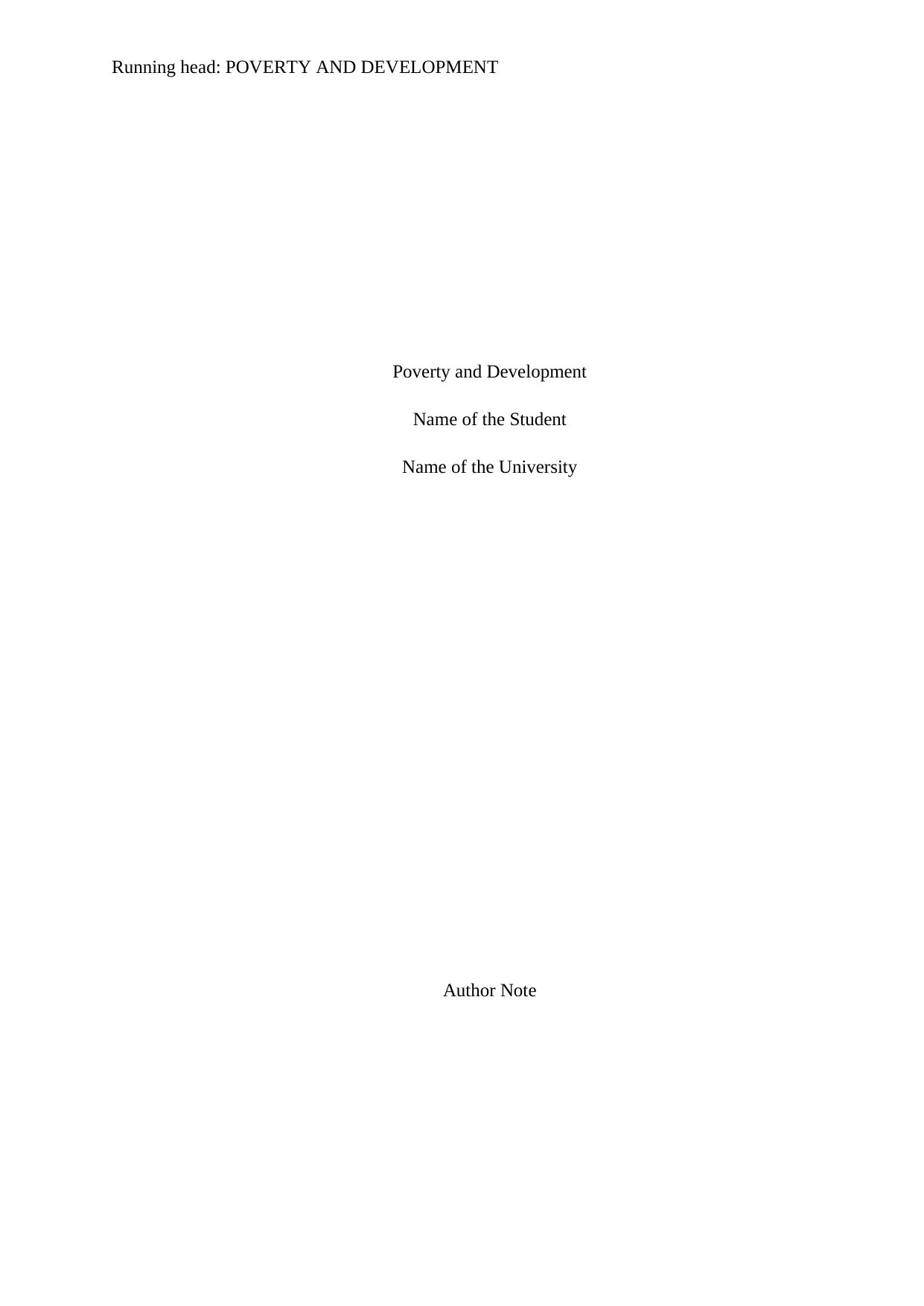
Running head: POVERTY AND DEVELOPMENT
Poverty and Development
Name of the Student
Name of the University
Author Note
Poverty and Development
Name of the Student
Name of the University
Author Note
Paraphrase This Document
Need a fresh take? Get an instant paraphrase of this document with our AI Paraphraser
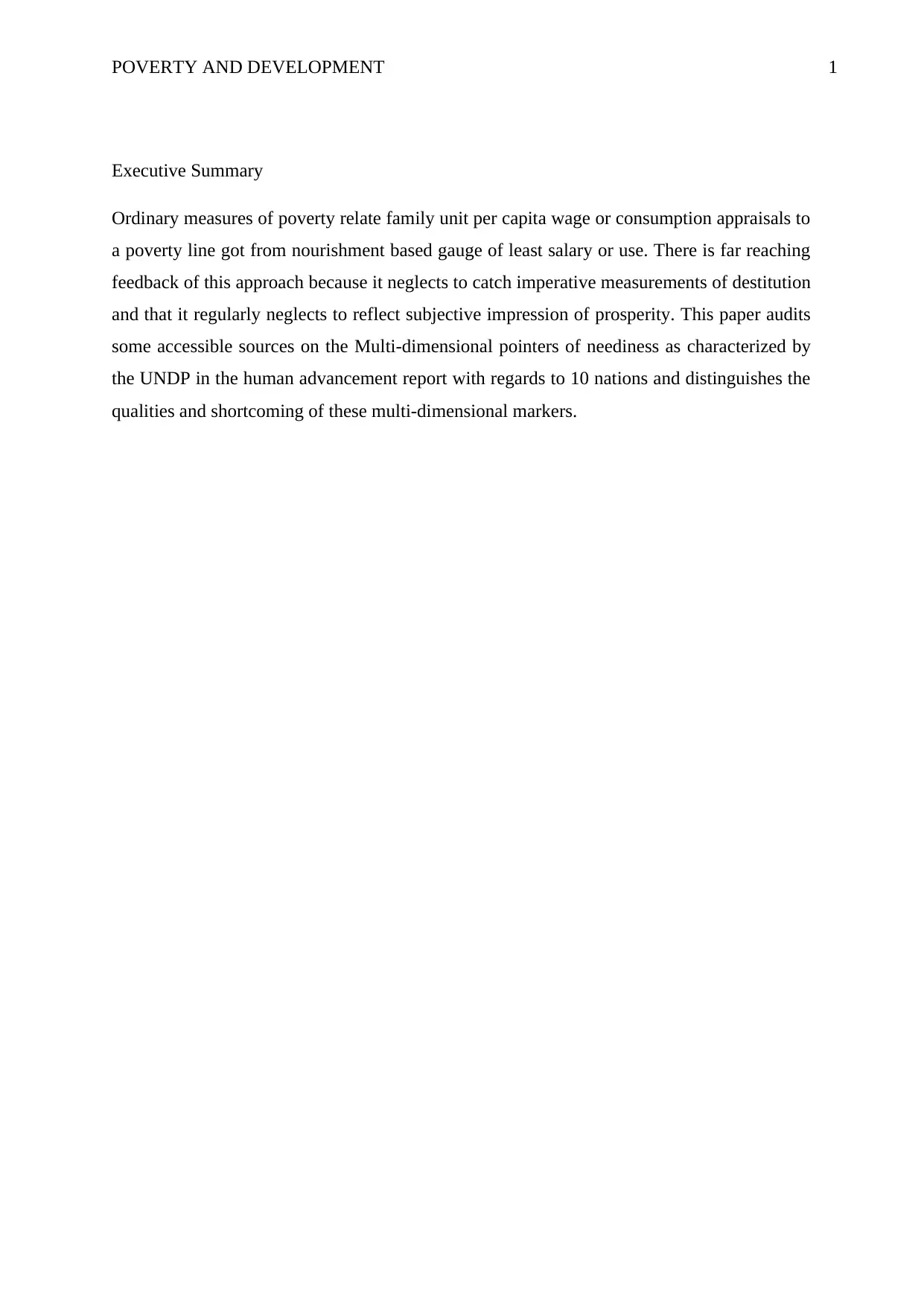
POVERTY AND DEVELOPMENT 1
Executive Summary
Ordinary measures of poverty relate family unit per capita wage or consumption appraisals to
a poverty line got from nourishment based gauge of least salary or use. There is far reaching
feedback of this approach because it neglects to catch imperative measurements of destitution
and that it regularly neglects to reflect subjective impression of prosperity. This paper audits
some accessible sources on the Multi-dimensional pointers of neediness as characterized by
the UNDP in the human advancement report with regards to 10 nations and distinguishes the
qualities and shortcoming of these multi-dimensional markers.
Executive Summary
Ordinary measures of poverty relate family unit per capita wage or consumption appraisals to
a poverty line got from nourishment based gauge of least salary or use. There is far reaching
feedback of this approach because it neglects to catch imperative measurements of destitution
and that it regularly neglects to reflect subjective impression of prosperity. This paper audits
some accessible sources on the Multi-dimensional pointers of neediness as characterized by
the UNDP in the human advancement report with regards to 10 nations and distinguishes the
qualities and shortcoming of these multi-dimensional markers.
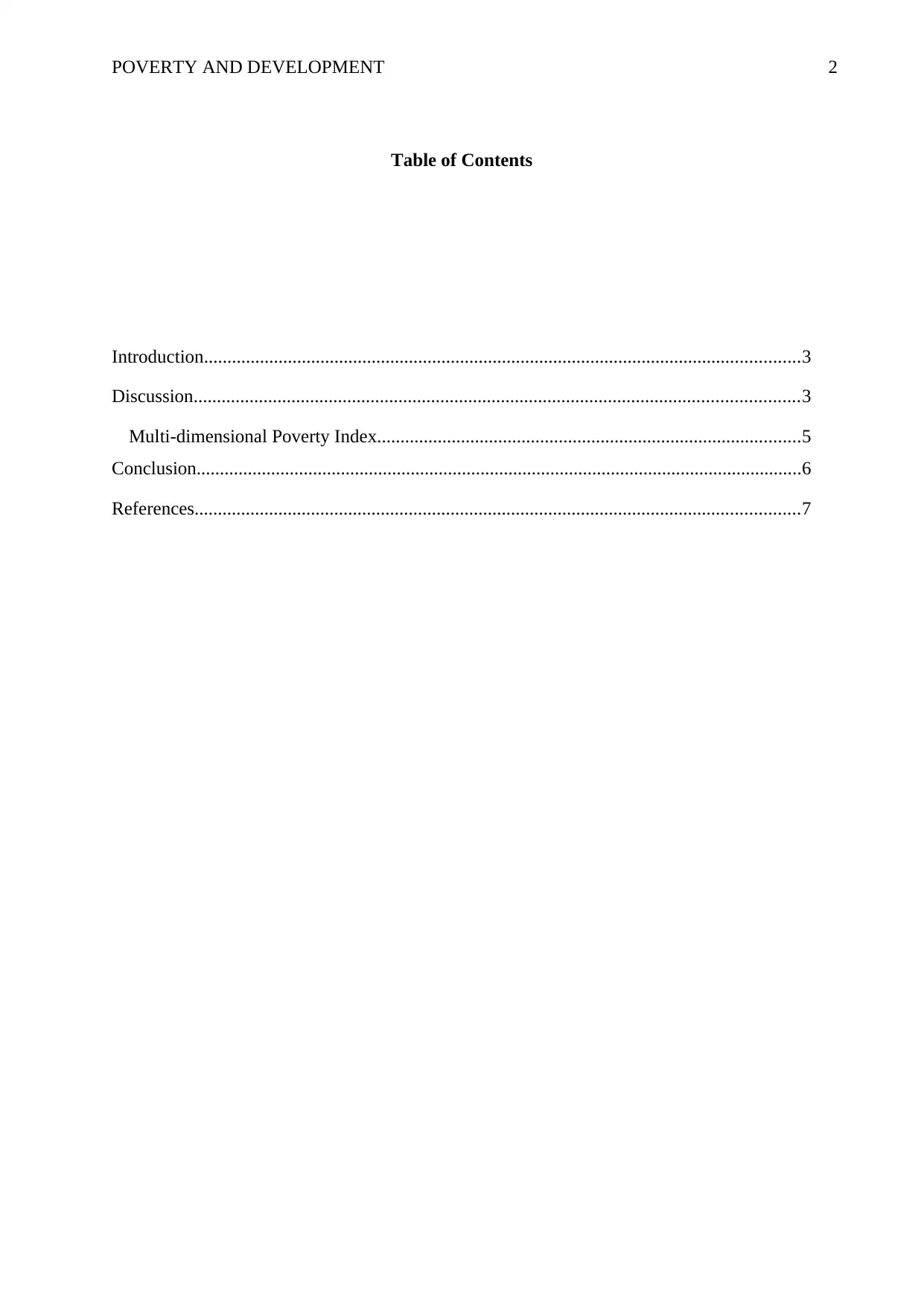
POVERTY AND DEVELOPMENT 2
Table of Contents
Introduction................................................................................................................................3
Discussion..................................................................................................................................3
Multi-dimensional Poverty Index...........................................................................................5
Conclusion..................................................................................................................................6
References..................................................................................................................................7
Table of Contents
Introduction................................................................................................................................3
Discussion..................................................................................................................................3
Multi-dimensional Poverty Index...........................................................................................5
Conclusion..................................................................................................................................6
References..................................................................................................................................7
⊘ This is a preview!⊘
Do you want full access?
Subscribe today to unlock all pages.

Trusted by 1+ million students worldwide
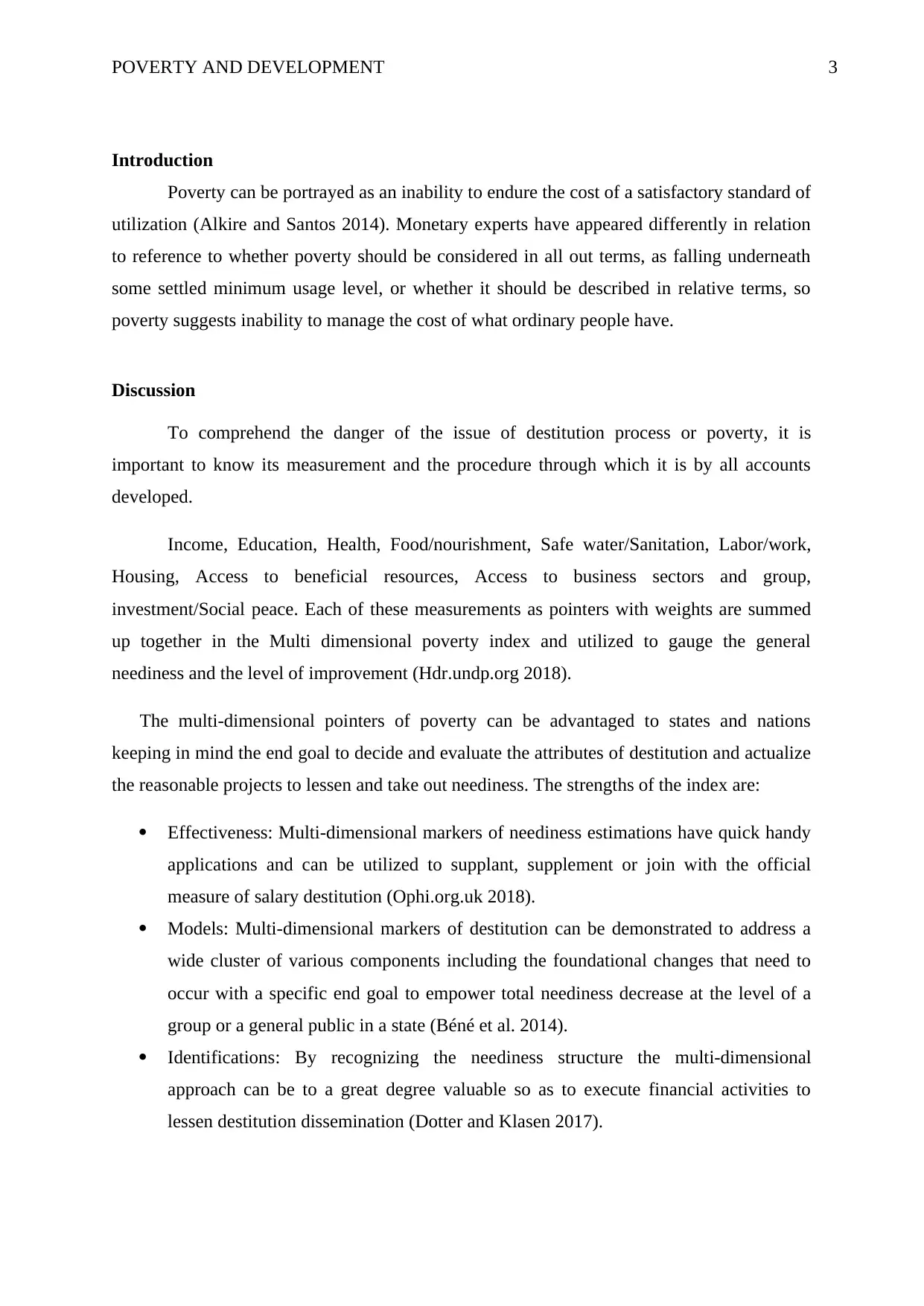
POVERTY AND DEVELOPMENT 3
Introduction
Poverty can be portrayed as an inability to endure the cost of a satisfactory standard of
utilization (Alkire and Santos 2014). Monetary experts have appeared differently in relation
to reference to whether poverty should be considered in all out terms, as falling underneath
some settled minimum usage level, or whether it should be described in relative terms, so
poverty suggests inability to manage the cost of what ordinary people have.
Discussion
To comprehend the danger of the issue of destitution process or poverty, it is
important to know its measurement and the procedure through which it is by all accounts
developed.
Income, Education, Health, Food/nourishment, Safe water/Sanitation, Labor/work,
Housing, Access to beneficial resources, Access to business sectors and group,
investment/Social peace. Each of these measurements as pointers with weights are summed
up together in the Multi dimensional poverty index and utilized to gauge the general
neediness and the level of improvement (Hdr.undp.org 2018).
The multi-dimensional pointers of poverty can be advantaged to states and nations
keeping in mind the end goal to decide and evaluate the attributes of destitution and actualize
the reasonable projects to lessen and take out neediness. The strengths of the index are:
Effectiveness: Multi-dimensional markers of neediness estimations have quick handy
applications and can be utilized to supplant, supplement or join with the official
measure of salary destitution (Ophi.org.uk 2018).
Models: Multi-dimensional markers of destitution can be demonstrated to address a
wide cluster of various components including the foundational changes that need to
occur with a specific end goal to empower total neediness decrease at the level of a
group or a general public in a state (Béné et al. 2014).
Identifications: By recognizing the neediness structure the multi-dimensional
approach can be to a great degree valuable so as to execute financial activities to
lessen destitution dissemination (Dotter and Klasen 2017).
Introduction
Poverty can be portrayed as an inability to endure the cost of a satisfactory standard of
utilization (Alkire and Santos 2014). Monetary experts have appeared differently in relation
to reference to whether poverty should be considered in all out terms, as falling underneath
some settled minimum usage level, or whether it should be described in relative terms, so
poverty suggests inability to manage the cost of what ordinary people have.
Discussion
To comprehend the danger of the issue of destitution process or poverty, it is
important to know its measurement and the procedure through which it is by all accounts
developed.
Income, Education, Health, Food/nourishment, Safe water/Sanitation, Labor/work,
Housing, Access to beneficial resources, Access to business sectors and group,
investment/Social peace. Each of these measurements as pointers with weights are summed
up together in the Multi dimensional poverty index and utilized to gauge the general
neediness and the level of improvement (Hdr.undp.org 2018).
The multi-dimensional pointers of poverty can be advantaged to states and nations
keeping in mind the end goal to decide and evaluate the attributes of destitution and actualize
the reasonable projects to lessen and take out neediness. The strengths of the index are:
Effectiveness: Multi-dimensional markers of neediness estimations have quick handy
applications and can be utilized to supplant, supplement or join with the official
measure of salary destitution (Ophi.org.uk 2018).
Models: Multi-dimensional markers of destitution can be demonstrated to address a
wide cluster of various components including the foundational changes that need to
occur with a specific end goal to empower total neediness decrease at the level of a
group or a general public in a state (Béné et al. 2014).
Identifications: By recognizing the neediness structure the multi-dimensional
approach can be to a great degree valuable so as to execute financial activities to
lessen destitution dissemination (Dotter and Klasen 2017).
Paraphrase This Document
Need a fresh take? Get an instant paraphrase of this document with our AI Paraphraser
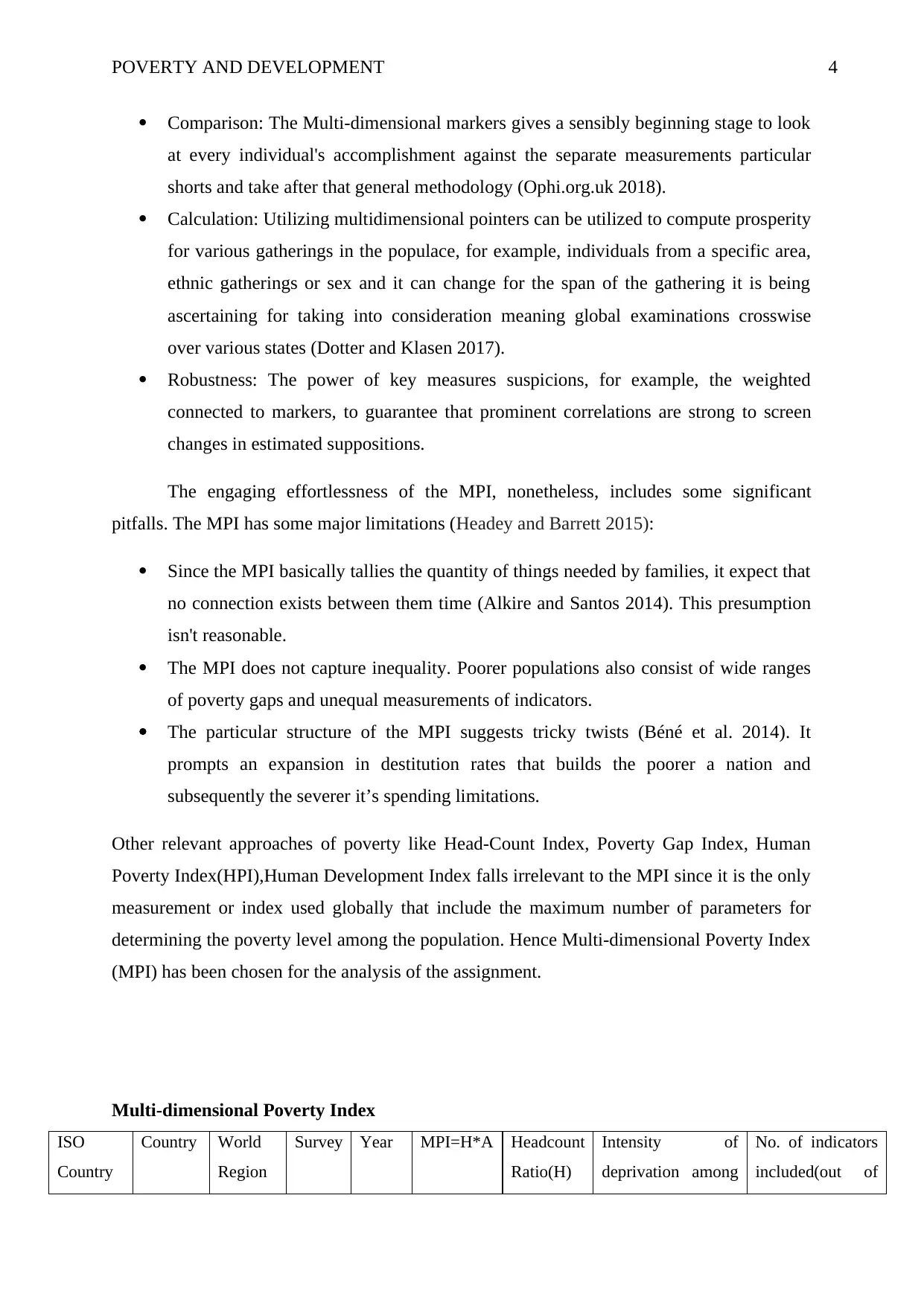
POVERTY AND DEVELOPMENT 4
Comparison: The Multi-dimensional markers gives a sensibly beginning stage to look
at every individual's accomplishment against the separate measurements particular
shorts and take after that general methodology (Ophi.org.uk 2018).
Calculation: Utilizing multidimensional pointers can be utilized to compute prosperity
for various gatherings in the populace, for example, individuals from a specific area,
ethnic gatherings or sex and it can change for the span of the gathering it is being
ascertaining for taking into consideration meaning global examinations crosswise
over various states (Dotter and Klasen 2017).
Robustness: The power of key measures suspicions, for example, the weighted
connected to markers, to guarantee that prominent correlations are strong to screen
changes in estimated suppositions.
The engaging effortlessness of the MPI, nonetheless, includes some significant
pitfalls. The MPI has some major limitations (Headey and Barrett 2015):
Since the MPI basically tallies the quantity of things needed by families, it expect that
no connection exists between them time (Alkire and Santos 2014). This presumption
isn't reasonable.
The MPI does not capture inequality. Poorer populations also consist of wide ranges
of poverty gaps and unequal measurements of indicators.
The particular structure of the MPI suggests tricky twists (Béné et al. 2014). It
prompts an expansion in destitution rates that builds the poorer a nation and
subsequently the severer it’s spending limitations.
Other relevant approaches of poverty like Head-Count Index, Poverty Gap Index, Human
Poverty Index(HPI),Human Development Index falls irrelevant to the MPI since it is the only
measurement or index used globally that include the maximum number of parameters for
determining the poverty level among the population. Hence Multi-dimensional Poverty Index
(MPI) has been chosen for the analysis of the assignment.
Multi-dimensional Poverty Index
ISO
Country
Country World
Region
Survey Year MPI=H*A Headcount
Ratio(H)
Intensity of
deprivation among
No. of indicators
included(out of
Comparison: The Multi-dimensional markers gives a sensibly beginning stage to look
at every individual's accomplishment against the separate measurements particular
shorts and take after that general methodology (Ophi.org.uk 2018).
Calculation: Utilizing multidimensional pointers can be utilized to compute prosperity
for various gatherings in the populace, for example, individuals from a specific area,
ethnic gatherings or sex and it can change for the span of the gathering it is being
ascertaining for taking into consideration meaning global examinations crosswise
over various states (Dotter and Klasen 2017).
Robustness: The power of key measures suspicions, for example, the weighted
connected to markers, to guarantee that prominent correlations are strong to screen
changes in estimated suppositions.
The engaging effortlessness of the MPI, nonetheless, includes some significant
pitfalls. The MPI has some major limitations (Headey and Barrett 2015):
Since the MPI basically tallies the quantity of things needed by families, it expect that
no connection exists between them time (Alkire and Santos 2014). This presumption
isn't reasonable.
The MPI does not capture inequality. Poorer populations also consist of wide ranges
of poverty gaps and unequal measurements of indicators.
The particular structure of the MPI suggests tricky twists (Béné et al. 2014). It
prompts an expansion in destitution rates that builds the poorer a nation and
subsequently the severer it’s spending limitations.
Other relevant approaches of poverty like Head-Count Index, Poverty Gap Index, Human
Poverty Index(HPI),Human Development Index falls irrelevant to the MPI since it is the only
measurement or index used globally that include the maximum number of parameters for
determining the poverty level among the population. Hence Multi-dimensional Poverty Index
(MPI) has been chosen for the analysis of the assignment.
Multi-dimensional Poverty Index
ISO
Country
Country World
Region
Survey Year MPI=H*A Headcount
Ratio(H)
Intensity of
deprivation among
No. of indicators
included(out of
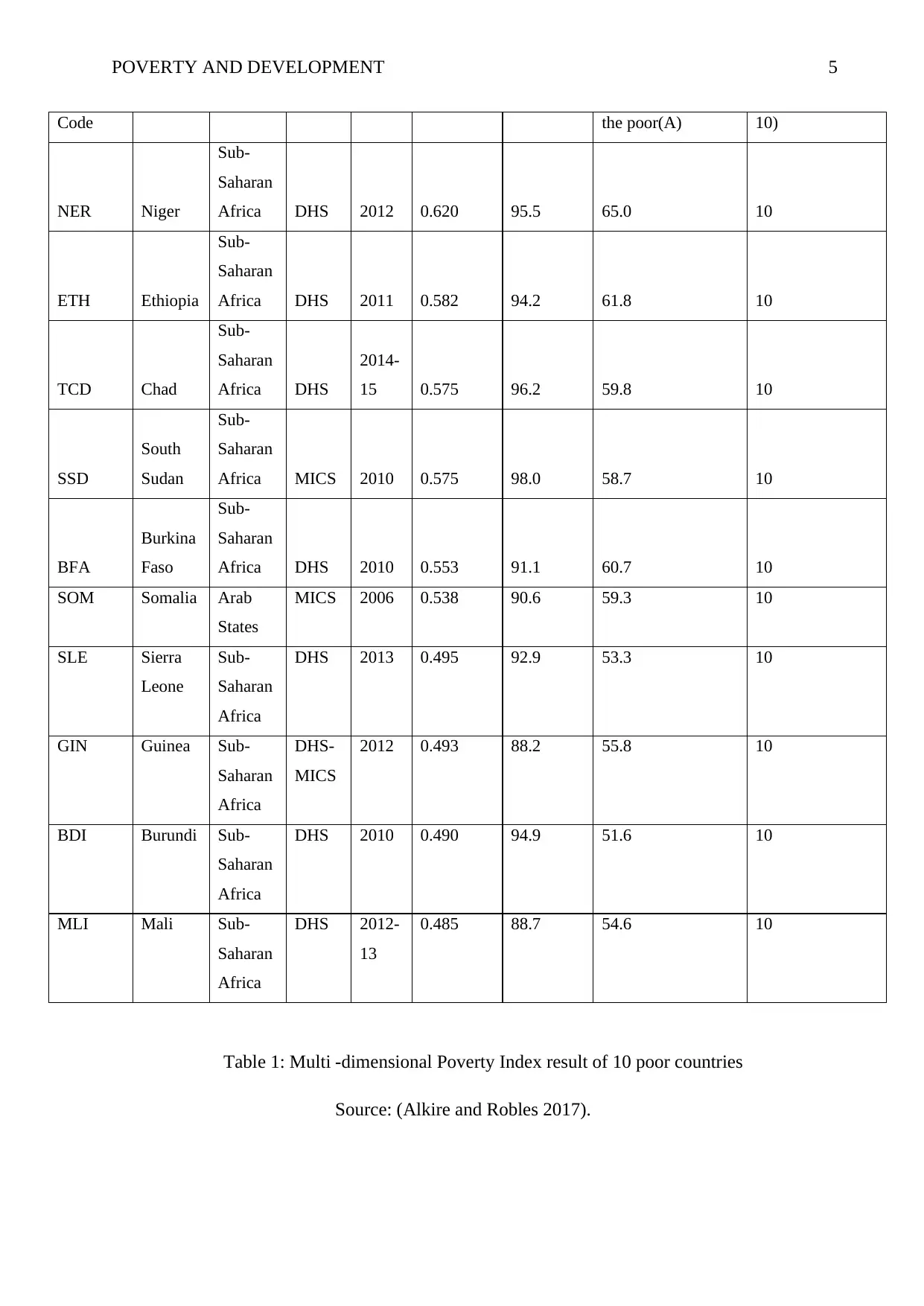
POVERTY AND DEVELOPMENT 5
Code the poor(A) 10)
NER Niger
Sub-
Saharan
Africa DHS 2012 0.620 95.5 65.0 10
ETH Ethiopia
Sub-
Saharan
Africa DHS 2011 0.582 94.2 61.8 10
TCD Chad
Sub-
Saharan
Africa DHS
2014-
15 0.575 96.2 59.8 10
SSD
South
Sudan
Sub-
Saharan
Africa MICS 2010 0.575 98.0 58.7 10
BFA
Burkina
Faso
Sub-
Saharan
Africa DHS 2010 0.553 91.1 60.7 10
SOM Somalia Arab
States
MICS 2006 0.538 90.6 59.3 10
SLE Sierra
Leone
Sub-
Saharan
Africa
DHS 2013 0.495 92.9 53.3 10
GIN Guinea Sub-
Saharan
Africa
DHS-
MICS
2012 0.493 88.2 55.8 10
BDI Burundi Sub-
Saharan
Africa
DHS 2010 0.490 94.9 51.6 10
MLI Mali Sub-
Saharan
Africa
DHS 2012-
13
0.485 88.7 54.6 10
Table 1: Multi -dimensional Poverty Index result of 10 poor countries
Source: (Alkire and Robles 2017).
Code the poor(A) 10)
NER Niger
Sub-
Saharan
Africa DHS 2012 0.620 95.5 65.0 10
ETH Ethiopia
Sub-
Saharan
Africa DHS 2011 0.582 94.2 61.8 10
TCD Chad
Sub-
Saharan
Africa DHS
2014-
15 0.575 96.2 59.8 10
SSD
South
Sudan
Sub-
Saharan
Africa MICS 2010 0.575 98.0 58.7 10
BFA
Burkina
Faso
Sub-
Saharan
Africa DHS 2010 0.553 91.1 60.7 10
SOM Somalia Arab
States
MICS 2006 0.538 90.6 59.3 10
SLE Sierra
Leone
Sub-
Saharan
Africa
DHS 2013 0.495 92.9 53.3 10
GIN Guinea Sub-
Saharan
Africa
DHS-
MICS
2012 0.493 88.2 55.8 10
BDI Burundi Sub-
Saharan
Africa
DHS 2010 0.490 94.9 51.6 10
MLI Mali Sub-
Saharan
Africa
DHS 2012-
13
0.485 88.7 54.6 10
Table 1: Multi -dimensional Poverty Index result of 10 poor countries
Source: (Alkire and Robles 2017).
⊘ This is a preview!⊘
Do you want full access?
Subscribe today to unlock all pages.

Trusted by 1+ million students worldwide
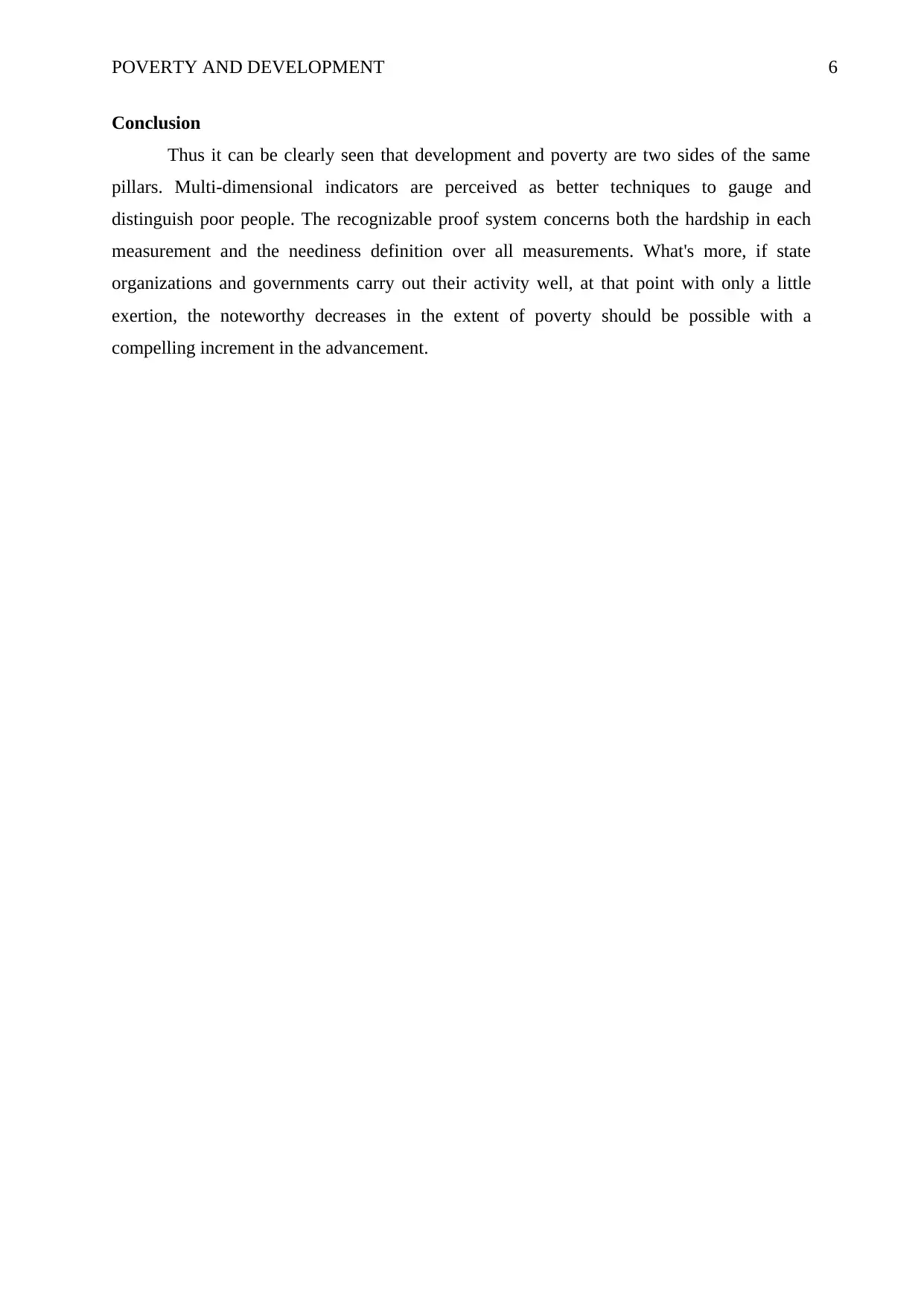
POVERTY AND DEVELOPMENT 6
Conclusion
Thus it can be clearly seen that development and poverty are two sides of the same
pillars. Multi-dimensional indicators are perceived as better techniques to gauge and
distinguish poor people. The recognizable proof system concerns both the hardship in each
measurement and the neediness definition over all measurements. What's more, if state
organizations and governments carry out their activity well, at that point with only a little
exertion, the noteworthy decreases in the extent of poverty should be possible with a
compelling increment in the advancement.
Conclusion
Thus it can be clearly seen that development and poverty are two sides of the same
pillars. Multi-dimensional indicators are perceived as better techniques to gauge and
distinguish poor people. The recognizable proof system concerns both the hardship in each
measurement and the neediness definition over all measurements. What's more, if state
organizations and governments carry out their activity well, at that point with only a little
exertion, the noteworthy decreases in the extent of poverty should be possible with a
compelling increment in the advancement.
Paraphrase This Document
Need a fresh take? Get an instant paraphrase of this document with our AI Paraphraser
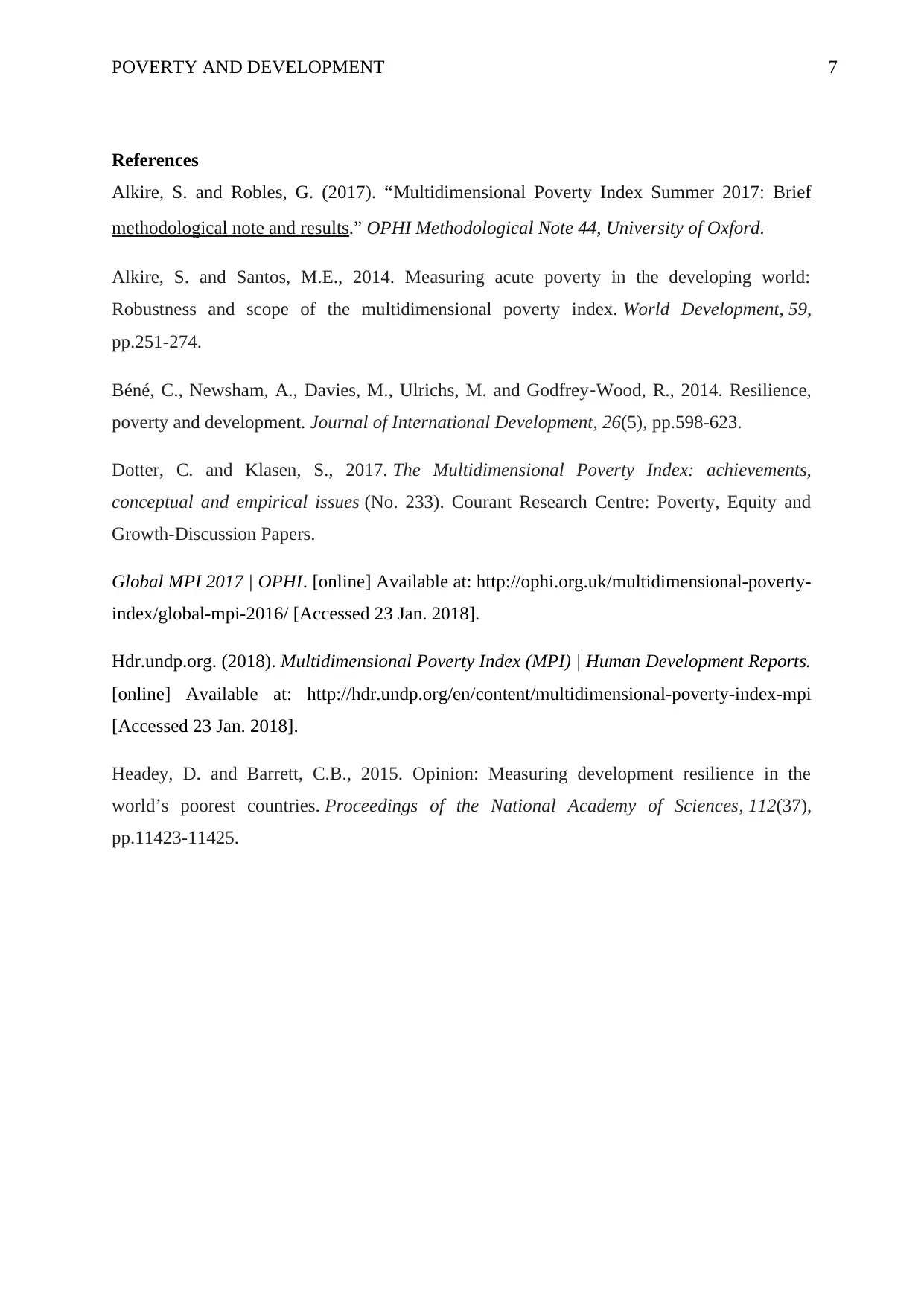
POVERTY AND DEVELOPMENT 7
References
Alkire, S. and Robles, G. (2017). “Multidimensional Poverty Index Summer 2017: Brief
methodological note and results.” OPHI Methodological Note 44, University of Oxford.
Alkire, S. and Santos, M.E., 2014. Measuring acute poverty in the developing world:
Robustness and scope of the multidimensional poverty index. World Development, 59,
pp.251-274.
Béné, C., Newsham, A., Davies, M., Ulrichs, M. and Godfrey‐Wood, R., 2014. Resilience,
poverty and development. Journal of International Development, 26(5), pp.598-623.
Dotter, C. and Klasen, S., 2017. The Multidimensional Poverty Index: achievements,
conceptual and empirical issues (No. 233). Courant Research Centre: Poverty, Equity and
Growth-Discussion Papers.
Global MPI 2017 | OPHI. [online] Available at: http://ophi.org.uk/multidimensional-poverty-
index/global-mpi-2016/ [Accessed 23 Jan. 2018].
Hdr.undp.org. (2018). Multidimensional Poverty Index (MPI) | Human Development Reports.
[online] Available at: http://hdr.undp.org/en/content/multidimensional-poverty-index-mpi
[Accessed 23 Jan. 2018].
Headey, D. and Barrett, C.B., 2015. Opinion: Measuring development resilience in the
world’s poorest countries. Proceedings of the National Academy of Sciences, 112(37),
pp.11423-11425.
References
Alkire, S. and Robles, G. (2017). “Multidimensional Poverty Index Summer 2017: Brief
methodological note and results.” OPHI Methodological Note 44, University of Oxford.
Alkire, S. and Santos, M.E., 2014. Measuring acute poverty in the developing world:
Robustness and scope of the multidimensional poverty index. World Development, 59,
pp.251-274.
Béné, C., Newsham, A., Davies, M., Ulrichs, M. and Godfrey‐Wood, R., 2014. Resilience,
poverty and development. Journal of International Development, 26(5), pp.598-623.
Dotter, C. and Klasen, S., 2017. The Multidimensional Poverty Index: achievements,
conceptual and empirical issues (No. 233). Courant Research Centre: Poverty, Equity and
Growth-Discussion Papers.
Global MPI 2017 | OPHI. [online] Available at: http://ophi.org.uk/multidimensional-poverty-
index/global-mpi-2016/ [Accessed 23 Jan. 2018].
Hdr.undp.org. (2018). Multidimensional Poverty Index (MPI) | Human Development Reports.
[online] Available at: http://hdr.undp.org/en/content/multidimensional-poverty-index-mpi
[Accessed 23 Jan. 2018].
Headey, D. and Barrett, C.B., 2015. Opinion: Measuring development resilience in the
world’s poorest countries. Proceedings of the National Academy of Sciences, 112(37),
pp.11423-11425.
1 out of 8
Your All-in-One AI-Powered Toolkit for Academic Success.
+13062052269
info@desklib.com
Available 24*7 on WhatsApp / Email
![[object Object]](/_next/static/media/star-bottom.7253800d.svg)
Unlock your academic potential
Copyright © 2020–2025 A2Z Services. All Rights Reserved. Developed and managed by ZUCOL.
